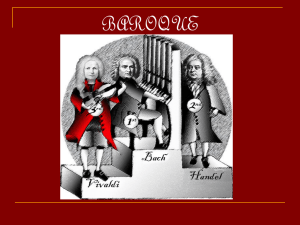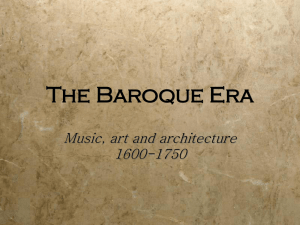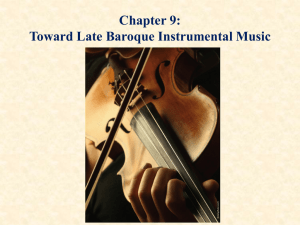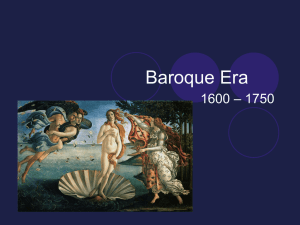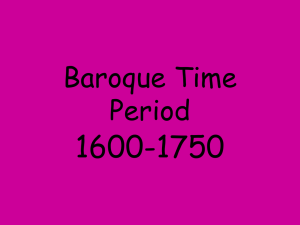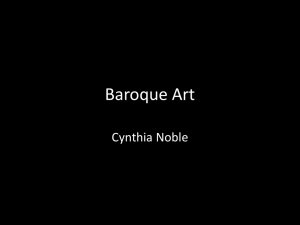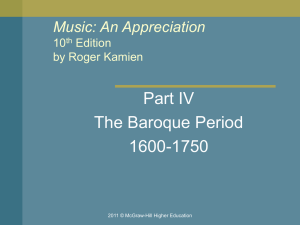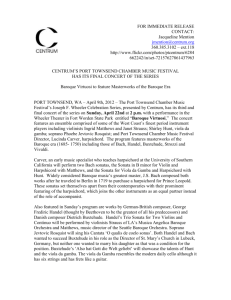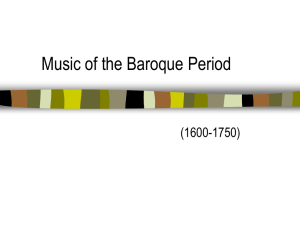Introduction to Music Class #17
advertisement
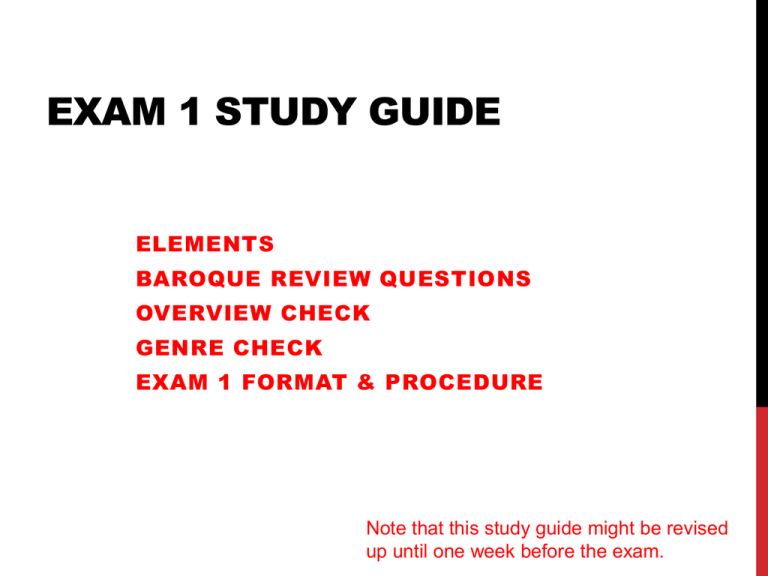
EXAM 1 STUDY GUIDE ELEMENTS BAROQUE REVIEW QUESTIONS OVERVIEW CHECK GENRE CHECK EXAM 1 FORMAT & PROCEDURE Note that this study guide might be revised up until one week before the exam. ELEMENTS REVIEW Term banks appear in Part I: Ch 1, 2 Part I: Ch 5, 6, 7 Part III: Ch 3, 10 Know definitions and sounds that terms create (e.g., “pizzicato”, a plucked string, creates a sound quite unlike that of a bowed string. Terms are on next slide. Know sounds of all producers listed on the next slide. CHAPTER 2: PERFORMING MEDIA KNOW ALL OF THE FOLLOWING BY SIGHT AND SOUND. Voices soprano alto tenor bass Keyboard piano harpsichord organ Electronic synthesizer Strings violin viola cello bass harp Woodwinds recorder flute oboe clarinet saxophone bassoon Brass Terms trumpet mute horn pizzicato trombone reed tuba mouthpiece Percussion vibrato timpani xylophone snare drum Very important helps: Connect Kamien McGraw-Hill web site YouTube Gems ELEMENTS REVIEW 1. Name the dynamic levels we will use this semester. 2. What is a melodic contour? 3. What is a theme? 4. Harmony: Generally, ________ resolves to ________. 5. Explain the most basic differences between monophony, polyphony, and homophony. 6. ________ imparts music’s characteristic rhythmic “feel.” 7. The position of a note head in, above, or below the staff communicates the sound’s ________. 8. Forms in music balance _________ and _________. 9. The feeling for key or tonality requires that a central tone, “DO,” be supported by appropriate ________ and ________. BAROQUE REVIEW 1. What is a basso continuo? What instruments might perform in a basso continuo? chording: _______, _______, _______ bass: _______, _______, _______ Name a genre that uses it. What is its function? (One word will do!) 2. In OPERA describe the role of: recitative aria Can you hear the difference between the opening recitative and the aria that follows in “Dido’s Lament”? REVIEW 3. 4. 5. 6. 7. 8. In opera, why is homophony favored over polyphony? What role did Monteverdi give the opera orchestra? How did he accomplish his goals for the orchestra? Explain how opera manifests the Baroque culture’s love of combining elements. Give some examples that illustrate the Baroque culture’s penchant for decorating “things.” What does “baroque” mean? Describe the following forms and explain how unity and contrast are projected in each: ritornello fugue AABB (often called binary form; common to dances) BAROQUE REVIEW 9. 10. 11. 12. 13. 14. 15. Describe the orchestra in the Baroque era. Which instrument family was most highly developed? Who is Antonio Stradivari, and what was his life’s work? What is an “absolute monarch”? Who is Louis XIV? Cite some aspects of his “summer home” that reflect baroque interests, tastes, needs, etc. Describe a typical court musician’s life. What is the Camerata? What genre did its members bring about? What is the difference between text (word) painting and text expression? BAROQUE REVIEW 16. Renaissance (16thC) complex polyphony gives way to early Baroque (17thC) ___________. What genre caused that change, and why did it do so? 17. Cite three important differences between the lives and music of Bach and Handel. 18. How do cantatas fit into the Lutheran worship service? 19. In what ways are opera and oratorio similar? Cite three VIMP differences between the genres. BAROQUE REVIEW 21. Describe each of the popular Baroque Era genres: opera cantata oratorio concerto chorale suite (dance suite) 22. Some terms from Baroque unit: ritornello recitative concerto grosso solo concerto cadenza French Overture tutti strophic aria ensemble overture basso continuo libretto BAROQUE LISTENING Bach, Brandenburg Concerto No. 5, mvt. 1 Vivaldi, Concerto for Violin and Orchestra (Spring) from the Four Seasons, mvt. 1 Bach, Organ Fugue in G Minor Monteverdi, Tu se morta from L’Orfeo Purcell, Dido’s Lament from Dido and Aeneas Bach, Bourée from Suite No. 3 in D Major Bach, Cantata No. 140 (Wachet Auf), Mvts. 4, 7 Handel, Ev’ry Valley Shall Be Exalted from Messiah Handel, Hallelujah Chorus from Messiah Entries in red are assigned as Self-Guided Studies. LISTENING SUMMARY •Bach •Brandenburg Concerto No. 5 in D Maj, Mvt. 1 •Concerto Grosso •I= – ritornello form – soloists=flute, violin, harpsichord – long harpsichord cadenza • a technical “tour de force” • much drive toward final ritornello Connect Kamien LISTENING SUMMARY •Vivaldi •Concerto for Violin & Orchestra, Op. 8, No. 1, (Spring from the Four Seasons ), Mvt. 1 •Concerto •I= – Ritornello form – Program music Connect Kamien LISTENING SUMMARY •Monteverdi •Tu sé morta from L’Orfeo •operatic recitative •I= – basso continuo accomp What two instruments do you hear? – text expression of mournful mood: • word painting • dark tone color • slow tempo LISTENING SUMMARY Purcell Dido’s Lament from Dido and Aeneas operatic aria (w/ recitative opening) I= • orchestra accomp • ground bass unifies • text expression of mournful mood: • • • • slow tempo minor key descending chromatic bass line “sighing” gesture Connect Kamien LISTENING SUMMARY Bach Orchestral Suite No. 3 in D Major, Bourrée Dance Suite Movement I= • Driving, exuberant rhythm • AABB form • Careful control of timbre Connect Kamien LISTENING SUMMARY Bach Cantata #140, (Wachet auf ) Sacred cantata I= • Mvt 4: 2 highly contrasting ideas combined in Ritornello-like organization • Mvt 7: simple homophonic chorale Connect Kamien LISTENING SUMMARY Handel Ev’ry Valley shall be Exalted from Messiah Aria from Oratorio I= • Word painting • Ritornello form Connect Kamien LISTENING SUMMARY Handel Hallelujah Chorus from Messiah Oratorio I= Frequent and sudden texture changes • Monophony, polyphony, homophony • Word painting Connect Kamien MATCH GENRES WITH THEIR DESCRIPTIONS Collection of dance-inspired movements Cantata Chorale Concerto Opera Oratorio Suite Multi-movement work for chorus, vocal soloists, orchestra, organ, most sacred ones are based on a familiar chorale Large-scale work combines visual, vocal & instrumental music, and literature Large-scale work for chorus, orchestra, narrator, usually based on Old Testament story A hymn, important in Lutheran worship service Multi-movement instrumental music that features two performing groups—soloist(s) and accompanying orchestra EXAM 1 TOPICS 1. General questions: Elements: terms, concepts Baroque Era: history, culture, music’s function Part III: Ch 1 & 2 1. 2. 3. 4. Architecture, décor, Baroque tastes & interests Technology and influence on music Visual arts Developments in music 2. Listening: Elements: instrument, voice recognition, performance technique terms Baroque listening—Pieces we have studied 3. Genre check EXAM 1 Op-Scan graded–bring pencil and eraser multiple-choice (a few true/false) 70 questions or less: 15-20 on vocabulary, history, culture, genres, etc. approximately 50 on listening elements, instruments, voices Baroque pieces Test session organization: 1. begin exam 2. listening–starts about 15 minutes into test session 3. quiet time to work on and/or finish non-listening part of exam 4. listening You may hear all of the music excerpts as often as you wish. You may take as much as or as little of the 50 minute class time as you wish.


